Circumflex branch of left coronary artery
The "LCX", or left circumflex artery (or circumflex artery, or circumflex branch of the left coronary artery) is an artery of the heart.
| Circumflex branch of left coronary artery | |
|---|---|
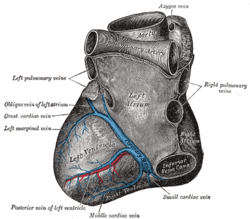 Base and diaphragmatic surface of heart. (Circumflex branch not visible, but would be near the coronary sinus.) | |
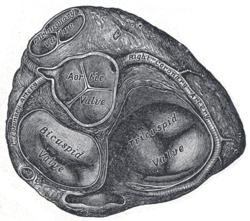 Base of ventricles exposed by removal of the atria. (Circumflex branch not visible, but bifurcation of left coronary artery visible at left.) | |
| Details | |
| Source | Left coronary artery |
| Branches | Left atrial branch left marginal artery posterolateral artery sinuatrial nodal artery (in some people) posterior interventricular artery (in some people) |
| Supplies | Posterolateral left ventricle, anterolateral papillary muscle, the sinoatrial nodal artery in 38% of people. |
| Identifiers | |
| Latin | Ramus circumflexus arteriae coronariae sinistrae |
| TA | A12.2.03.206 |
| FMA | 3895 |
| Anatomical terminology | |
Course
It follows the left part of the coronary sulcus, running first to the left and then to the right, reaching nearly as far as the posterior longitudinal sulcus. There have been multiple anomalies described, for example the left circumflex having an aberrant course from the right coronary artery.[1]
Branches
The circumflex artery curves to the left around the heart within the coronary sulcus, giving rise to one or more left marginal arteries (also called obtuse marginal branches (OM)) as it curves toward the posterior surface of the heart. It helps form the posterior left ventricular branch or posterolateral artery. The circumflex artery ends at the point where it joins to form to the posterior interventricular artery in 15% of all cases, which lies in the posterior interventricular sulcus. In the other 85% of all cases the posterior interventricular artery comes out of the right coronary artery.[2] When the left circumflex supplies the posterior descending artery in those 15% of cases, it is known as a left dominant circulation.
Structures supplied
The LCX supplies the posterolateral left ventricle and the anterolateral papillary muscle.
It also supplies the sinoatrial nodal artery in 38% of people.
It supplies 15-25% of the left ventricle in right-dominant systems. If the coronary anatomy is left-dominant, the LCX supplies 40-50% of the left ventricle. (See Coronary circulation for description of dominance.)
Additional images
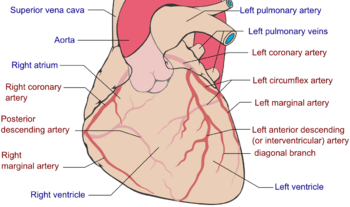
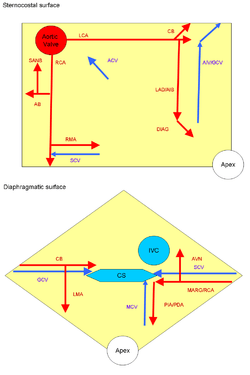 Cardiac vessels
Cardiac vessels Human heart with coronary arteries
Human heart with coronary arteries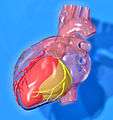 Heart coronary territories
Heart coronary territories Heart left lateral coronaries diagram
Heart left lateral coronaries diagram
References
This article incorporates text in the public domain from page 547 of the 20th edition of Gray's Anatomy (1918)
- PAGE, H. L.; ENGEL, H. J.; CAMPBELL, W. B.; THOMAS, C. S. (1 October 1974). "Anomalous Origin of the Left Circumflex Coronary Artery: Recognition, Angiographic Demonstration and Clinical Significance". Circulation. 50 (4): 768–773. doi:10.1161/01.CIR.50.4.768.
- Keith L. Moore; Arthur F. Dalley; Anne M.R. Agur (2010). Clinically oriented anatomy (6th ed.). Philadelphia: Wolters Kluwer Health/Lippincott Williams & Wilkins. p. 145. ISBN 9780781775250.
External links
- Anatomy figure: 20:03-03 at Human Anatomy Online, SUNY Downstate Medical Center - "Anterior view of the heart."
- Anatomy figure: 20:04-01 at Human Anatomy Online, SUNY Downstate Medical Center - "Posterior view of the heart."
- Anatomy photo:20:09-0104 at the SUNY Downstate Medical Center - "Heart: The Left Coronary Artery and its Branches"
- Image at merck.com
- Overview and diagrams at cardiologysite.com